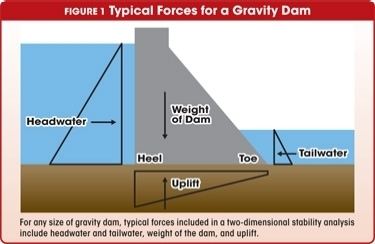 | ||
Similar Embankment dam , Buttress dam , Detention dam | ||
adi forces acting on gravity dam ce in hindi
A gravity dam is a dam constructed from concrete or stone masonry and designed to hold back water by primarily utilizing the weight of the material alone to resist the horizontal pressure of water pushing against it. Gravity dams are designed so that each section of the dam is stable, independent of any other dam section.
Contents

Gravity dams generally require stiff rock foundations of high bearing strength (slightly weathered to fresh); although they have been built on soil foundations in rare cases. The bearing strength of the foundation limits the allowable position of the resultant which influences the overall stability. Also, the stiff nature of the gravity dam structure is unforgiving to differential foundation settlement; which can induce cracking of the dam structure.

Gravity dams provide some advantages over embankment dams. The main advantage being that they can tolerate minor over topping flows as the concrete is resistant to scouring. Large overtopping flows are still a problem, as they can scour the foundations if not accounted for in the design. A disadvantage of gravity dams is that due to their large footprint, they are susceptible to uplift pressures which act as a de-stabilising force. Uplift pressures (buoyancy) can be reduced by internal and foundation drainage systems which reduces the pressures.

During construction, the setting concrete produces a exothermic reaction. This heat expands the plastic concrete and can take up to several decades to cool. When cooling, the concrete is in a stiff state and is susceptible to cracking. It is the designer's task to ensure this doesn't occur.

The most common classification of gravity dams is by the materials composing the structure:
Composite dams are a combination of concrete and embankment dams. Construction materials of composite dams are the same used for concrete and embankment dams.
Gravity dams can be classified by plan (shape):
Gravity dams can be classified with respect to their structural height:
